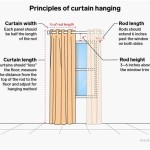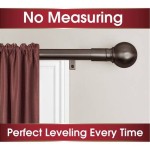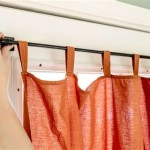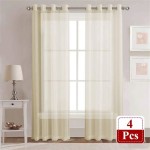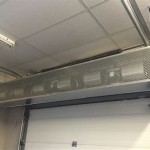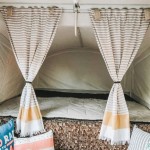Weighted Bags for Outdoor Curtains: Functionality and Application
Outdoor curtains offer an effective means of enhancing outdoor living spaces by providing privacy, shade, and a touch of aesthetic appeal. However, their lightweight nature makes them susceptible to wind, causing them to billow, flap, and potentially damage surrounding structures. Weighted bags offer a practical solution to this problem, providing stability and preventing unwanted movement. This article explores the functionality, applications, and considerations associated with weighted bags for outdoor curtains.
Understanding the Need for Weighted Bags
Outdoor curtains are typically made from materials like polyester, canvas, or similar fabrics chosen for their weather resistance and durability. These materials, while robust against rain and sun, are inherently lightweight. Consequently, even a moderate breeze can cause significant movement. The flapping of curtains can be disruptive, creating noise and potentially damaging the fabric or the curtain rod. More importantly, excessive movement compromises the intended purpose of the curtains, negating their ability to provide privacy or effective shade. Furthermore, continuously billowing curtains can pose a safety hazard, especially in areas near open flames or walkways.
Traditional methods of securing outdoor curtains, such as tying them back or using rods at the bottom, can be cumbersome and may not be aesthetically pleasing. Tying curtains back limits their functionality, reducing the area they cover and potentially creating uneven distribution of shade or privacy. Bottom rods, while effective, can be visually obtrusive and require careful installation to avoid damaging the curtain or the surrounding structure.
Weighted bags, on the other hand, offer a discreet and effective solution. They add weight to the bottom of the curtains, preventing them from lifting and flapping in the wind without significantly altering their appearance or functionality. The weight provided by the bags anchors the curtains, allowing them to hang more gracefully and maintain their position even in windy conditions. This stability enhances the overall functionality of the curtains, ensuring they provide the intended level of privacy, shade, and aesthetic appeal.
Types and Materials of Weighted Bags
Weighted bags for outdoor curtains are available in various materials, shapes, and sizes, each offering different advantages and disadvantages. The choice of material depends on factors such as durability, weather resistance, aesthetic appeal, and cost. Common materials include:
*Fabric:
Fabric bags, typically made from weather-resistant materials like canvas or polyester, are a popular choice. They can be easily sewn or purchased pre-made. The fabric can be chosen to complement the color and style of the curtains, providing a seamless and aesthetically pleasing integration. The filling for fabric bags can vary, including sand, pebbles, or metal pellets. *Mesh:
Mesh bags are often used when drainage is a concern. The mesh material allows water to escape, preventing the bags from becoming waterlogged and heavy. This is particularly important in areas with frequent rainfall. Mesh bags are typically filled with pebbles or gravel to provide weight while maintaining good drainage. *Vinyl:
Vinyl bags offer excellent water resistance and durability. They are easy to clean and maintain, making them a practical choice for outdoor use. Vinyl bags are typically filled with sand or metal pellets. *Metal:
Although less common, metal weights encased in protective fabric or rubber are also available. These weights offer a high density, providing significant anchoring force in a small package. However, they can be more expensive than other options.The filling material also plays a crucial role in the effectiveness of the weighted bag. Common filling materials include:
*Sand:
Sand is a readily available and relatively inexpensive option. It provides good weight and is easily contained within a fabric or vinyl bag. However, sand can become heavy when wet and may leak if the bag is damaged. *Pebbles/Gravel:
Pebbles or gravel offer good drainage and are less prone to becoming heavy when wet compared to sand. They are also readily available and relatively inexpensive. However, pebbles can be less dense than sand, requiring a larger volume to achieve the same weight. *Metal Pellets:
Metal pellets, such as steel shot or lead shot, provide a high density, allowing for a significant amount of weight to be packed into a small bag. This is advantageous in situations where space is limited or a more discreet solution is desired. However, metal pellets are typically more expensive than sand or pebbles.The shape and size of the weighted bags should be chosen to complement the style and size of the curtains. Small, discreet bags can be attached to the bottom hem of the curtains, while larger bags can be placed in pockets sewn into the bottom of the curtains for a more integrated look. The weight of the bags should be sufficient to anchor the curtains without causing them to sag excessively. Experimentation may be required to determine the optimal weight for a given set of curtains.
Methods of Attachment and Implementation
Several methods can be used to attach weighted bags to outdoor curtains, each offering different advantages in terms of ease of installation, security, and aesthetics. The specific method chosen will depend on the design of the curtains, the type of weighted bags used, and the desired level of permanence.
*Sewing:
Sewing weighted bags directly into the bottom hem of the curtains is a secure and discreet method of attachment. This involves creating small pockets in the hem and inserting the weighted bags before stitching the pockets closed. This method provides a clean and integrated look, minimizing the visibility of the bags. However, it requires sewing skills and may make it difficult to remove or adjust the weights later on. *Clips:
Clips or hooks can be used to attach weighted bags to the bottom of the curtains. This method is relatively simple and requires no sewing. Clips can be easily attached and detached, allowing for easy adjustment of the weights as needed. However, clips may be visible and potentially detract from the aesthetic appeal of the curtains. The clips should be made of rust-resistant materials such as stainless steel to withstand outdoor conditions. *Velcro:
Velcro strips can be used to attach weighted bags to the bottom of the curtains. One strip is sewn onto the bottom hem of the curtain, and the other is attached to the weighted bag. This method allows for easy attachment and removal of the bags. However, the Velcro strips may be visible and may not be as secure as sewing or clipping. *Pockets with Velcro Closure:
Creating pockets in the bottom hem of the curtains with Velcro closures offers a combination of security and ease of use. The pockets provide a discreet and integrated look, while the Velcro closures allow for easy access to the weighted bags for adjustment or removal. This method requires some sewing skills but offers a good balance of functionality and aesthetics.Regardless of the attachment method chosen, it is essential to ensure that the weighted bags are securely attached to the curtains to prevent them from falling off and potentially causing injury or damage. Regular inspection of the attachment points is recommended to identify and address any signs of wear or damage.
Factors Influencing Weight Requirements
Determining the appropriate weight for outdoor curtain bags is influenced by several factors, requiring careful assessment to ensure optimal performance. Insufficient weight will render the bags ineffective, while excessive weight could strain the curtain fabric and hardware.
One of the primary factors is the
fabric weight
of the curtain itself. Heavier fabrics naturally require less additional weight compared to lightweight materials. Assessing the fabric's resistance to wind is crucial. A tightly woven, heavier material will resist billowing more effectively than a sheer, lightweight fabric.The
curtain height and width
also play a significant role. Taller and wider curtains present a larger surface area vulnerable to wind pressure, necessitating more weight for stabilization. The area of exposure to wind correlates directly with the amount of force exerted on the curtain. Logically, larger curtains will require more weight placed strategically along their bottom edge.Prevailing
wind conditions
in the specific location are a critical determinant. Areas prone to strong, gusty winds demand heavier weighted bags. Consider seasonal variations; locations experiencing higher wind speeds during specific seasons might require adjustments in weight accordingly. Observing the typical wind patterns will guide an informed decision-making process.The
suspension method
of the curtains influences weight requirements as well. Curtains suspended from a single rod might experience greater sway compared to those secured at both the top and bottom. The more secure the initial suspension, the less reliance need be placed on the weighted bags. A secure top fixing inherently reduces the amount of weight needed at the bottom.Finally, the
desired aesthetic
contributes to determining the appropriate weight. The goal is to stabilize the curtains without causing them to sag excessively or appear unnaturally stiff. The weight should be sufficient to control movement but not so heavy as to detract from the overall appearance. Finding the right balance between functionality and aesthetics is key.Maintenance and Longevity
Maintaining weighted bags for outdoor curtains extends their lifespan and ensures continued effectiveness. Regular inspections and preventative measures are vital, especially given their exposure to diverse weather conditions.
One crucial aspect is
protection from moisture
. Regardless of the bag material, prolonged exposure to water can lead to deterioration and mold growth. Fabric bags are especially susceptible; ensure they are treated with water-repellent coatings. If the filling material is sand or pebbles, ensure the bag is properly sealed to prevent leakage and water infiltration. During periods of heavy rain or snowfall, consider temporarily removing the bags to prevent excessive moisture absorption. Allowing the bags to air dry periodically will also inhibit mold growth.Protection from UV radiation
is equally important. Prolonged exposure to sunlight can degrade the fabric or vinyl of the bags, leading to cracking or fading. Choose materials with UV-resistant properties. Consider shading the curtains and bags during the hottest parts of the day to minimize UV exposure. Regularly applying UV protectant sprays can further extend the material's lifespan.Regular cleaning
is essential to remove dirt, debris, and mildew. Use a mild soap and water solution to clean the bags, being careful to avoid harsh chemicals that could damage the material. For fabric bags, consider machine washing on a gentle cycle, provided the filling material is securely contained. Rinse thoroughly and allow to air dry completely before reattaching to the curtains. For vinyl bags, simply wipe down with a damp cloth.Seasonal storage
contributes significantly to longevity. During periods of prolonged disuse, such as winter months in colder climates, remove the weighted bags and store them in a dry, sheltered location. This prevents damage from freezing temperatures, snow, and ice. Proper storage extends the usable life of the bags considerably.Finally,
periodic inspection and repair
are crucial for identifying and addressing potential problems. Check for tears in the fabric, loose seams, and signs of degradation in the filling material. Repair minor tears promptly to prevent them from escalating. Replace damaged bags immediately to maintain optimal performance and prevent further damage to the curtains.
8 Pack Outdoor Curtain Weights 15oz Sandbag Weighted Bags Bottom

Windproof Outdoor Curtain Accessories Weight Temu Belgium

New 4 8 12 Sets Of Outdoor Curtain Windproof Weights Decorative Bags And Clips Weight Fixed On

New 4 8 12 Sets Of Outdoor Curtain Windproof Weights Decorative Bags And Clips Weight Fixed On

Outdoor Curtain Weight Bags Patio Weights Canvas Sandbag Drapery With Metal Clips Seal For Gazebo Curtains Pergola Drapes The Best S In Coolbe

8 Sets Outdoor Curtain Weight Bag Weights Heavy Curtains Weighted Bottom Uk

Windproof Outdoor Curtain Accessories Weight Temu Belgium

Curtain Anchor Weights Curanchor Oc Outdoorcurtains Com

Outdoor Curtain Weight Bags Patio Weights Canvas Sandbag Drapery With Metal Clips Seal For Gazebo Curtains Pergola Drapes The Best S In Coolbe

Outdoor Sandbag Weight Bags For Curtains 8 Packs With Clips And Seal


